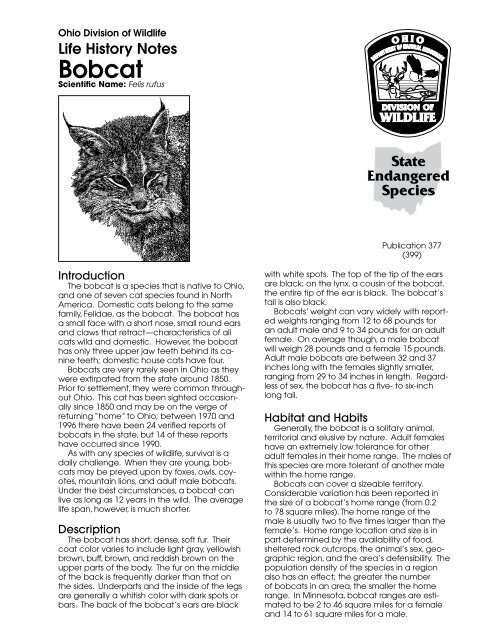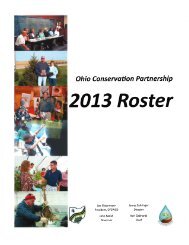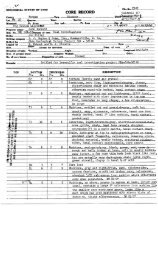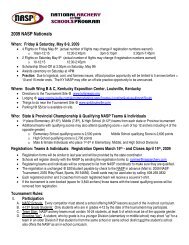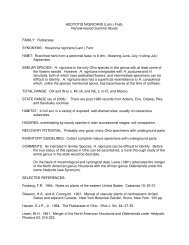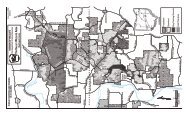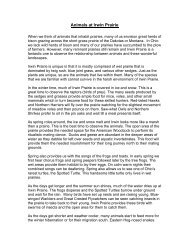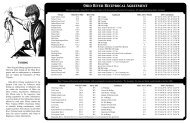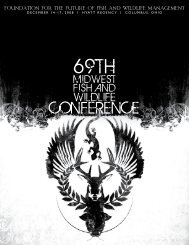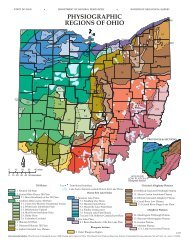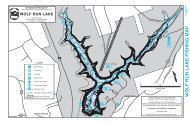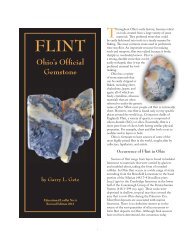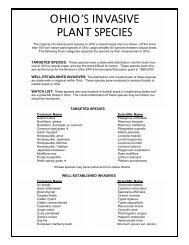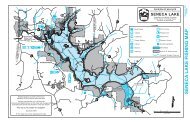Create successful ePaper yourself
Turn your PDF publications into a flip-book with our unique Google optimized e-Paper software.
Ohio Division of Wildlife<br />
<strong>Life</strong> <strong>History</strong> <strong>Notes</strong><br />
<strong>Bobcat</strong><br />
Scientific Name: Felis rufus<br />
Introduction<br />
The bobcat is a species that is native to Ohio,<br />
and one of seven cat species found in North<br />
America. Domestic cats belong to the same<br />
family, Felidae, as the bobcat. The bobcat has<br />
a small face with a short nose, small round ears<br />
and claws that retract—characteristics of all<br />
cats wild and domestic. However, the bobcat<br />
has only three upper jaw teeth behind its canine<br />
teeth; domestic house cats have four.<br />
<strong>Bobcat</strong>s are very rarely seen in Ohio as they<br />
were extirpated from the state around 1850.<br />
Prior to settlement, they were common throughout<br />
Ohio. This cat has been sighted occasionally<br />
since 1850 and may be on the verge of<br />
returning “home” to Ohio; between 1970 and<br />
1996 there have been 24 verified reports of<br />
bobcats in the state, but 14 of these reports<br />
have occurred since 1990.<br />
As with any species of wildlife, survival is a<br />
daily challenge. When they are young, bobcats<br />
may be preyed upon by foxes, owls, coyotes,<br />
mountain lions, and adult male bobcats.<br />
Under the best circumstances, a bobcat can<br />
live as long as 12 years in the wild. The average<br />
life span, however, is much shorter.<br />
Description<br />
The bobcat has short, dense, soft fur. Their<br />
coat color varies to include light gray, yellowish<br />
brown, buff, brown, and reddish brown on the<br />
upper parts of the body. The fur on the middle<br />
of the back is frequently darker than that on<br />
the sides. Underparts and the inside of the legs<br />
are generally a whitish color with dark spots or<br />
bars. The back of the bobcat’s ears are black<br />
State<br />
Endangered<br />
Species<br />
Publication 377<br />
(399)<br />
with white spots. The top of the tip of the ears<br />
are black; on the lynx, a cousin of the bobcat,<br />
the entire tip of the ear is black. The bobcat’s<br />
tail is also black.<br />
<strong>Bobcat</strong>s’ weight can vary widely with reported<br />
weights ranging from 12 to 68 pounds for<br />
an adult male and 9 to 34 pounds for an adult<br />
female. On average though, a male bobcat<br />
will weigh 28 pounds and a female 15 pounds.<br />
Adult male bobcats are between 32 and 37<br />
inches long with the females slightly smaller,<br />
ranging from 29 to 34 inches in length. Regardless<br />
of sex, the bobcat has a five- to six-inch<br />
long tail.<br />
Habitat and Habits<br />
Generally, the bobcat is a solitary animal,<br />
territorial and elusive by nature. Adult females<br />
have an extremely low tolerance for other<br />
adult females in their home range. The males of<br />
this species are more tolerant of another male<br />
within the home range.<br />
<strong>Bobcat</strong>s can cover a sizeable territory.<br />
Considerable variation has been reported in<br />
the size of a bobcat’s home range (from 0.2<br />
to 78 square miles). The home range of the<br />
male is usually two to five times larger than the<br />
female’s. Home range location and size is in<br />
part determined by the availability of food,<br />
sheltered rock outcrops, the animal’s sex, geographic<br />
region, and the area’s defensibility. The<br />
population density of the species in a region<br />
also has an effect; the greater the number<br />
of bobcats in an area, the smaller the home<br />
range. In Minnesota, bobcat ranges are estimated<br />
to be 2 to 46 square miles for a female<br />
and 14 to 61 square miles for a male.
<strong>Bobcat</strong>s aren’t as aggressive hunters as<br />
might be expected; they generally lie in wait<br />
for their prey, pouncing when an animal comes<br />
near. Prey pursuit rarely extends more than 60<br />
feet. Rabbits and rodents are the bobcat’s<br />
principal food. Deer are also occasionally<br />
taken, especially in the northern portions of the<br />
bobcat’s continental range. Deer are killed<br />
by a bite through the neck, either in the jugular<br />
or spine region. Once killed, the bobcat<br />
will consume the hindquarters of the deer first.<br />
Uneaten portions are frequently stored and hidden<br />
and then consumed over a period of days.<br />
<strong>Bobcat</strong>s will also consume insects, fish, reptiles,<br />
amphibians, birds, and other mammals.<br />
<strong>Bobcat</strong>s are considered crepuscular; they<br />
are most active in both the early evening and<br />
early morning hours. However, they may move<br />
around at anytime during the day or night.<br />
Most activities occur from three hours before<br />
sunset and on to midnight and begin again an<br />
hour before until approximately four hours after<br />
sunrise.<br />
<strong>Bobcat</strong>s have a range that extends throughout<br />
North America from southern Canada to<br />
northern Mexico, except along the mid-Atlantic<br />
Coast and through the Midwest where intensive<br />
human habitation and agriculture have<br />
led to its extirpation. <strong>Bobcat</strong>s may be found in<br />
a wide variety of habitats ranging from lowland<br />
swamps to partially forested mountainous<br />
areas; understory density can vary from open<br />
areas such as a stand of pines to more dense<br />
areas of growth like a regenerating clear cut<br />
area.<br />
Reproduction and Care of Young<br />
<strong>Bobcat</strong>s are polygamous breeders, meaning<br />
the male will mate with more than one female<br />
and no bond is established between the pair.<br />
Females of this species become sexually mature<br />
at 9 to 12 months of age; males are about<br />
18 months old before they reach sexual maturity.<br />
<strong>Bobcat</strong>s remain capable of reproducing<br />
throughout their lives.<br />
Breeding may occur at anytime throughout<br />
the year; mostly it occurs from December<br />
through May with kittens produced about 63<br />
days after mating. When available, the female<br />
will use an area of rock outcroppings as<br />
a natal den. The average litter size is two or<br />
three kittens, but as few as one and as many<br />
as six young may be born to a litter. The young<br />
are born helpless and are dependent on the<br />
mother. At birth, the bobcat is completely<br />
furred with its eyes closed. Young bobcats’ eyes<br />
will open in 3 to 11 days, 10 days is typical. The<br />
young are fully weaned at eight weeks and<br />
they will disperse and begin life on their own in<br />
the fall and late winter.<br />
Females generally produce one litter a year.<br />
A female that loses a litter may produce another<br />
litter in the same year. This is possible because<br />
bobcats are spontaneous ovulators—estrus<br />
occurs every 40 to 44 days in females that<br />
have failed to conceive.<br />
Management Plans<br />
<strong>Bobcat</strong>s are classified as an endangered<br />
species in Ohio. Their status in the state is monitored<br />
through verified records and reported<br />
observations. They are afforded full protection<br />
under the law.<br />
Viewing Opportunities<br />
Due to their naturally elusive and secretive<br />
behavior patterns, an extremely low population,<br />
and the limited range within Ohio, the chance<br />
to see this endangered animal is limited. An<br />
encounter with a bobcat in this state is a rarity.<br />
Virtually all verified records of bobcats have<br />
been confined to the eastern, southeastern,<br />
and south-central regions of Ohio.<br />
Do Something Wild!<br />
The bobcat is among the majority of wildlife<br />
species in Ohio that are not hunted. All of these<br />
animals are vital parts of our overall ecosystem<br />
and contribute to wildlife diversity in the state.<br />
Helping us manage and research these species<br />
are the generous citizens of Ohio. With money<br />
they either donated through the state income<br />
tax checkoff, by the purchase of a wildlife<br />
license plate, or their direct contribution to the<br />
Endangered Species Special Account, the Division<br />
is able to purchase critical habitat essential<br />
to sustaining endangered species or provide<br />
educational materials on species such as the<br />
bobcat.<br />
Contributions to our Endangered Species<br />
and Wildlife Diversity Program are accepted<br />
throughout the year. To make a donation,<br />
please send a check to: Endangered Species<br />
Special Account, Ohio Division of Wildlife, 2045<br />
Morse Road, Bldg. G, Columbus, Ohio 43229-<br />
6693. All contributions, whether made on your<br />
income tax return or directly, are tax deductible.
At a Glance<br />
Mating: Polygamous<br />
Peak of Breeding Activity: December through<br />
May<br />
Gestation: 63 days<br />
Young Are Born: Most litters are produced<br />
between early February and late July. Kittens<br />
are helpless and totally dependent on the<br />
female.<br />
Litter Size: Litters range from 1 to 6 kittens.<br />
Average is 2+.<br />
Number of Litters per Year: Typically 1. A second<br />
litter may be produced if the first litter is lost.<br />
Adult Weight: The range is from 12-68 pounds<br />
for males and 9-34 for females. Male average is<br />
28 pounds and female average is 15 pounds.<br />
Adult Length: Males are 32-37 inches; females<br />
are 29-34 inches.<br />
<strong>Life</strong> Expectancy: 12 years; the average is<br />
much less.<br />
Migration Patterns: Non-migratory<br />
Activity Periods: <strong>Bobcat</strong>s are crepuscular;<br />
most movement occurs during the late afternoon<br />
and early evening hours and for a few<br />
hours at sunrise.<br />
Typical Foods: <strong>Bobcat</strong>s are carnivores and<br />
will consume a wide variety of insects, reptiles,<br />
amphibians, fish, birds, and mammals. Rabbits<br />
and, in northern latitudes, white-tailed deer are<br />
important components of the bobcat’s diet.<br />
Native to Ohio: Yes<br />
Active or Potential Nuisance Species: No,<br />
but may be perceived by some as a potential<br />
threat.<br />
The bobcat is classified as a state endangered<br />
species and receives full protection<br />
under Ohio law.


